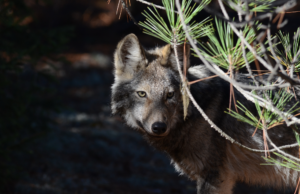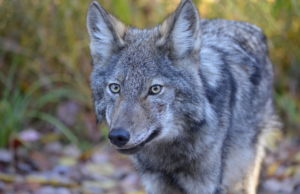5 Facts About the Algonquin Wolf You Need to Know: Species at Risk Series
Author: Stacy Corneau
We want to share our love for the animals and plants calling Ottawa Valley home. In this new monthly series, we’re spotlighting species at risk across Ontario and Quebec, what makes them unique, and what can be done to protect them and their habitats.
But first: what is a species at risk?
Species at risk are animals and plants in danger of disappearing from Canada’s wild unless we act quickly.
The provincial and federal governments use five terms to categorize at risk species in Canada depending on their threat status:
- Special concern: species which may become threatened or endangered due to threats to their habitats or themselves.
- Threatened: species in the wild not yet endangered but likely to become so if urgent steps aren’t taken to stop activities threatening them or their habitats.
- Endangered: wild species close to becoming extirpated or extinct and if action isn’t taken soon, we could lose species in this category – possibly forever.
- Extirpated: the final step before complete extinction, extirpation is when a species can no longer live in its native habitat in Ontario or Quebec but can be found elsewhere in the world.
- Extinct: species no longer in existence.
While many things can lead to a species becoming at risk, habitat loss and degradation caused by clear-cut logging, mining, oil, and roads or housing developments are a few of the human dangers these species face.
Why are we talking about species at risk?
CPAWS-OV is the voice for the wilderness in Eastern Ontario and Western Quebec. We promote conservation and management of our rich natural resources on public lands.
We do so by fighting for protection of Ottawa Valley’s wild ecosystems in parks, wilderness, and similar natural areas to preserve the full diversity of habitats and their species.
These animals and plants need a home. We want to protect our lands and waters so they can thrive for generations to come.

The Algonquin Wolf
The first animal we’re spotlighting in this series is the Algonquin wolf, also known as the Eastern Wolf and Canis Lycaon.
What is their status?
The Government of Ontario and the Committee on the Status of Endangered Wildlife in Canada (COSEWIC) have labelled the Algonquin wolf as threatened. The Algonquin wolf isn’t endangered yet but could be soon if action isn’t taken to protect its habitat.
Where do they live?
You can find the Algonquin wolf in central Ontario, southwestern Quebec, and southern areas of northeastern Ontario and northwestern Ontario.
They’re not restricted to any specific type of habitat, though they’re often found in mixed forest landscapes.
Algonquin wolves are particularly concentrated in Algonquin Provincial Park and nearby protected areas, including Kawartha Highlands and Queen Elizabeth II Wildlands Provincial Parks.
 What do they look like?
What do they look like?
The Algonquin wolf is part of the canine family, resulting from hybridization between the grey wolf and coyote thousands of years ago.
Their muzzle, ears, and lower legs tend to be reddish-brown, whereas the fur on their backs may be a combination of black, white, and grey fur.
A male Algonquin wolf can grow to about 65 pounds, whereas a female will become approximately 50 pounds.
The Algonquin wolf is smaller than a grey wolf, which can grow to over 150 pounds and up to five feet in length. However, Algonquin wolves are larger than coyotes, which can weigh as little as 20 pounds and be less than three feet long.
What do they eat?
Wolves are carnivores, and the Algonquin wolf is no exception! Beaver, white-tailed deer, and moose are the main choices for this meat lover.
How do they communicate?
Howling! The classic “Awoo” from films and television came from real life wolves like the Algonquin wolf.
Although they can use noise such as growls or barks, as well as smell and body language, howling is a preferred method of communication. It’s especially useful for long-distance communication. The Algonquin wolf can hear sounds up to 10 km away. The strength in their howls is remarkable, letting other wolves in their pack know where they are, encouraging their pack before or after a hunt, or warning other packs nearby of their presence.
 What threatens the Algonquin wolf?
What threatens the Algonquin wolf?
Human-caused mortality is a major risk for the Algonquin wolf.
Acts like hunting and trapping, residential road or housing development, and extractives or agricultural activities continue to chip away at what little habitat the Algonquin wolf has left.
The expansion of road networks and urbanization outside protected areas also deters population expansion, leading to habitat fragmentation and loss.
Excessive mortality rates can limit the Algonquin wolf’s willingness to roam across larger distances. This forces pack breeding dynamics to change, leading to hybridization with Eastern coyotes due to a lack of suitable mates within their own species.
What can be done to protect the Algonquin wolf?
Ottawa Valley’s parks and natural spaces are home to the Algonquin wolf. This is why we’re working to protect these luscious landscapes to conserve biodiversity, protect their habitats, and slow the pace of species extinction.
Specifically, we campaigned for a wolf protection zone around Algonquin Park and the 40 adjacent counties, resulting in pack structures improving and numbers stabilizing due to less mortality.
If you want to help protect the Algonquin wolf, contact your MP, MPP, and local councillor asking them to establish new protected areas in the Madawaska Highlands as the Algonquin wolves in that area also experience the risks of hunting and trapping.
This is the first blog in our new monthly series highlighting species at risk. Next month, we’ll be discussing the Eastern cougar. Stay tuned!
